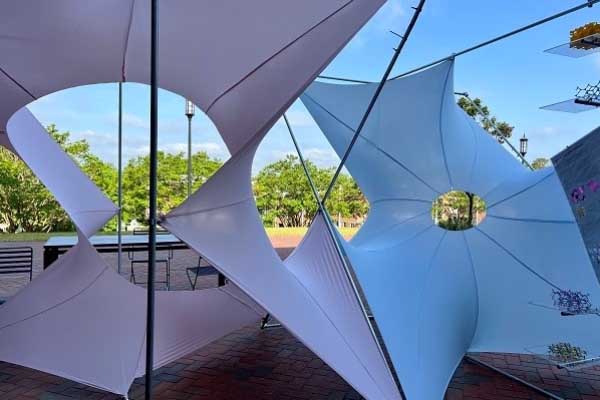Architecture, chemistry students join forces for pop-up museum project

A group of architecture and chemistry students spent the spring semester working together to translate the nanoscale of chemistry to the macroscale of architecture.
Students from the Graduate Topic Studio, led by Rachel Dickey, assistant professor of architecture, and graduate research assistants from the lab of Christopher Bejger, associate professor of chemistry, teamed to design proposals for a nanoscale science pop-up museum. They built full-scale components, which were displayed at the Science Building for a juried competition.
Working in five teams, the students sought to demonstrate the structure and inner workings of metal-organic frameworks or MOFs, crystalline porous solids composed of a three-dimensional network of metal ions held in place by organic linkers.
First identified in the 1990s by Omar Yaghi, a professor at the University of California, Berkeley, MOFs are central to Bejger’s research, which is focused on the design, synthesis and assembly of molecular clusters for energy applications. In 2021, Bejger received a National Science Foundation CAREER Award from the Solid State and Materials Chemistry program in the Division of Materials Research. The award included the interdisciplinary work with Dickey and her students to create a teaching tool for school and community settings that would make learning about MOFs experiential, interactive and fun.
“I was writing the NSF CAREER proposal in the summer of 2016 and was wanting to develop a unique outreach component related to the materials my group studies and prepares in the lab,” Bejger said.
More than five years later, Ph.D. nanoscale science and graduate chemistry students from Bejger’s lab joined Dickey’s Master of Architecture students for an afternoon design charrette.
“The architecture students also spent an afternoon in the chemistry lab, where each student synthesized a metal-organic framework, looked at their crystals using a microscope and learned about chemical purification and characterization processes,” said Dickey. “The architecture students remained in contact with the chemistry students and continued to discuss their projects whenever they had questions related to the chemistry concepts.”
Hannah Guffey, a Master of Architecture student, found that while architecture is “full of perspective views and is rather arbitrary to one’s own ideas,” and chemistry is “full of facts and is more theoretical,” both disciplines “hold creativity within them.” She noted, “Designers tweak designs the way chemists tweak formulas and properties of substances.”
The project, “The Container and Contained” (pictured above) was named the winner of the May 2 juried competition for its “elegant, excellent craft, periodic structure like MOF, interlocking lattices and appeal for all ages.” Judges stated it demonstrated the “best balance of chemistry and architecture.”
Designed by Guffey, Hanieh Sotudeh Gharebaagh and Parham Pazouki, the project will be built during the summer for public use next academic year and beyond.
Read the entire story on the College of Arts + Architecture website, which includes additional images of the student projects.